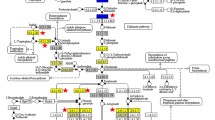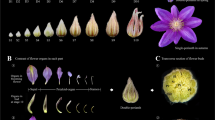Abstract
Homeotic changes played a considerable role during the evolution of flowers, but how floral homeotic mutants initially survive in nature has remained enigmatic. To better understand the evolutionary potential of floral homeotic mutants, we established as a model system Stamenoid petals (Spe), a natural variant of Capsella bursa-pastoris (Brassicaceae). In the flowers of Spe plants, petals are transformed into stamens, whereas all other floral organs are unaffected. In contrast with most other homeotic mutants, the Spe variant occurs in relatively stable populations in the wild. In order to determine how the profound change in floral architecture influences plant performance in the wild, we performed common garden experiments running over 3 years. Here, we show that Spe and wild-type plants attract the same assemblage of floral visitors: mainly hoverflies, wild bees and thrips. However, floral visitation is about twice as frequent in wild-type plants as in Spe plants. Nevertheless, the numbers of seeds per fruit were about the same in both variants. Wild-type plants produced more flowers, fruits and seeds per plant than Spe plants, whereas the germination capacity of Spe seeds was higher than that of the wild-type. Determination of volatile composition revealed monoterpenes and 3,4-dimethylbenzaldehyde, which were detected only in wild-type flowers, presumably because they are produced only by petals. Our data indicate that the similar fitness of Spe and wild-type C. bursa-pastoris in the field results from complex compensation between plant architecture and germination capacity. In contrast, flower structure and floral visitation are only of minor importance, possibly because C. bursa-pastoris is mainly self-pollinating.





Similar content being viewed by others
References
Abel C, Clauss M, Schaub A, Gershenzon J, Tholl D (2009) Floral and insect-induced volatile formation in Arabidopsis lyrata ssp. petraea, a perennial, outcrossing relative of A. thaliana. Planta 230:1–11
Bartholmes C, Nutt P, Theißen G (2008) Germline transformation of shepherd’s purse (Capsella bursa-pastoris) by the ‘floral dip’ method as a tool for evolutionary and developmental biology. Gene 409:11–19
Bateman RM, Hilton J, Rudall PJ (2006) Morphological and molecular phylogenetic context of the angiosperms: contrasting the ‘top-down’ and ‘bottom-up’ approaches used to infer the likely characteristics of the first flowers. J Exp Bot 57:3471–3503
Baum DA, Hileman LC (2006) A developmental genetic model for the origin of the flower. In: Ainsworth C (ed) Flowering and its manipulation. Blackwell, Sheffield, pp 3–27
Bosbach K, Hurka H, Haase R (1982) The soil seed bank of Capsella bursa-pastoris (Cruciferae): its influence on population variability. Flora 172:47–56
Coen ES, Meyerowitz EM (1991) The war of the whorls: genetic interactions controlling flower development. Nature 353:31–37
Cubas P, Vincent C, Coen ES (1999) An epigenetic mutation responsible for natural variation in floral symmetry. Nature 401:157–161
Darwin C (1859) On the origin of species by means of natural selection or the preservation of favoured races in the struggle for life. John Murray, London
Darwin C (1876) The variation of animals and plants under domestication, 2nd edn. D. Appleton, New York
Dudareva N, Negre F, Nagegowda DA, Orlova I (2006) Plant volatiles: recent advances and future perspectives. Crit Rev Plant Sci 25:417–440
Endress PK (1994) Diversity and evolutionary biology of tropical flowers. Cambridge University Press, Cambridge
Ferrario S, Immink RG, Angenent GC (2004) Conservation and diversity in flower land. Curr Opin Plant Biol 7:84–91
Ford VS, Gottlieb LD (1992) Bicalyx is a natural homeotic floral variant. Nature 358:671–673
Frohlich MW (2003) An evolutionary scenario for the origin of flowers. Nat Rev Genet 4:559–566
Hameister S, Neuffer B, Bleeker W (2009) Genetic differentiation and reproductive isolation of a naturally occurring floral homeotic mutant within a wild-type population of Capsella bursa-pastoris (Brassicaceae). Mol Ecol 18:2659–2667
Hintz M, Bartholmes C, Nutt P, Ziermann J, Hameister S, Neuffer B, Theißen G (2006) Catching a ‘hopeful monster’: shepherd’s purse (Capsella bursa-pastoris) as a model system to study the evolution of floral development. J Exp Bot 57:3531–3542
Hoffmann MH, Bremer M, Schneider K, Burger F, Stolle E, Moritz G (2003) Flower visitors in a natural population of Arabidopsis thaliana. Plant Biol 5:491–494
Hurka H, Neuffer B (1997) Evolutionary processes in the genus Capsella (Brassicaceae). Plant Syst Evol 206:295–316
Hurka H, Freundner S, Brown AHD, Plantholt U (1989) Aspartat aminotransferase isozymes in the genus Capsella (Brassicaceae): subcellular location, gene duplication and polymorphism. Biochem Genet 27:77–90
Kanno A, Saeki H, Kameya T, Saedler H, Theißen G (2003) Heterotopic expression of class B floral homeotic genes supports a modified ABC model for tulip (Tulipa gesneriana). Plant Mol Biol 52:831–841
Knudsen JT, Eriksson R, Gershenzon J, Stahl B (2006) Diversity and distribution of floral scent. Bot Rev 72:1–120
Krizek BA, Fletcher JC (2005) Molecular mechanisms of flower development: an armchair guide. Nat Rev Genet 6:688–698
Meyerowitz EM, Smyth DR, Bowman JL (1989) Abnormal flowers and pattern formation in floral development. Development 106:209–217
Murbeck SV (1918) Über staminale Pseudapetalie und deren Bedeutung für die Frage nach der Herkunft der Blütenkrone, N.F. Avd. 2, Bd. 14, Nr. 25. Lunds Universitets Arsskrift, Lund
Neuffer B (1990) Ecotype differentiation in Capsella. Vegetatio 89:165–171
Nutt P, Ziermann J, Hintz M, Neuffer B, Theißen G (2006) Capsella as a model system to study the evolutionary relevance of floral homeotic mutants. Plant Syst Evol 259:217–235
Opiz PM (1821) 2. Capsella apetala Opiz. Eine neue merkwürdige Pflanze. Flora 4:436–443
R Development Core Team (2006) R—a language and environment. R Foundation for Statistical Computing, Vienna, Austria
Reichert H (1998) Eine kronblattlose Sippe des Hirtentäschels (Capsella bursa-pastoris) seit Jahren bestandsbildend bei Gau-Odernheim/Rheinhessen. Hessische Floristische Rundbriefe 47:53–55
Salisbury EJ (1963) Intermittent germination in Capsella. Nature 199:1303–1304
Sattler R (1988) Homeosis in plants. Am J Bot 75:1606–1617
Silvertown JW (1987) Introduction to plant population ecology. Longman, New York
Theißen G (2000) Evolutionary developmental genetics of floral symmetry: the revealing power of Linnaeus’ monstrous flower. Bioessays 22:209–213
Theißen G (2006) The proper place of hopeful monsters in evolutionary biology. Theory Biosci 124:349–369
Theißen G (2009) Saltational evolution: hopeful monsters are here to stay. Theory Biosci 128:43–51
Theißen G, Becker A, Winter KU, Muenster T, Kirchner C, Saedler H (2002) How the land plants learned their floral ABCs: the role of MADS box genes in the evolutionary origin of flowers. In: Cronk QC, Bateman RM, Hawkins JM (eds) Developmental genetics and plant evolution. Taylor & Francis, London, pp 173–206
Verdonk JC, Ric de Vos CH, Verhoeven HA, Haring MA, van Tunen AJ, Schuurink RC (2003) Regulation of floral scent production in Petunia revealed by targeted metabolomics. Phytochemistry 62:997–1008
Wolf JB, Wade MJ (2001) On the assignment of fitness to parents and offspring: whose fitness is it and when does it matter? J Evol Biol 14:347–356
Acknowledgments
We gratefully acknowledge E. Stolle and F. Burger (Institute of Zoology, Halle) for taxonomic determination of Syrphidae and bees plus wasps, respectively. We also thank the undergraduate students Stefan Lukas, Christine Steinbach, Katja Kühdorf, Ulrike Schure and Sophie Bartsch for help in observations of the plots, and Jeanette Keim and Ulrike Schure for counting fruits and seeds. Many thanks also to Richard Bateman, David Roberts and an anonymous reviewer for valuable comments and suggestions that helped considerably to improve a previous version of this manuscript. We are especially grateful to Richard Bateman for his continuous encouragement to work on this topic. This project was supported by grants from the Deutsche Forschungsgemeinschaft (TH 417/4-1 and -2 to G.T., NE 314/7-1 and -2 to B.N.).
Author information
Authors and Affiliations
Corresponding author
Electronic supplementary material
Below is the link to the electronic supplementary material.
Rights and permissions
About this article
Cite this article
Ziermann, J., Ritz, M.S., Hameister, S. et al. Floral visitation and reproductive traits of Stamenoid petals, a naturally occurring floral homeotic variant of Capsella bursa-pastoris (Brassicaceae). Planta 230, 1239–1249 (2009). https://doi.org/10.1007/s00425-009-1018-z
Received:
Accepted:
Published:
Issue Date:
DOI: https://doi.org/10.1007/s00425-009-1018-z




